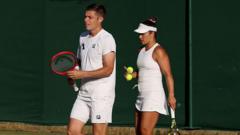What Did Thibaut Courtois Say About Manuel Neuer's Criticism of Gianluigi Donnarumma?

Thibaut Courtois Defends Gianluigi Donnarumma Amid Controversy
The world of football is rife with emotions, rivalries, and moments that can change the course of a game—and sometimes, a player’s career. Recently, Real Madrid’s goalkeeper Thibaut Courtois came forth to defend Paris Saint-Germain’s Gianluigi Donnarumma following a harrowing incident involving Bayern Munich’s Jamal Musiala. This incident, which resulted in a serious injury to Musiala, has sparked a heated debate in the football community about the nature of goalkeeping, player safety, and accountability.
This article delves into the incident, the surrounding reactions, and the broader implications for the sport. We will explore the responsibilities of goalkeepers, the nature of injuries in football, and how the football community can foster a safer environment for all players.
The Incident: What Happened?
During a tense quarter-final match of the Club World Cup, PSG faced off against Bayern Munich. The game, which ended 2-0 in favor of PSG, was overshadowed by a shocking incident involving Jamal Musiala. As Musiala attempted to seize the ball, he collided awkwardly with Donnarumma, resulting in a horrific injury.
Musiala’s leg became trapped between the pitch and Donnarumma’s body, leading to a fibula fracture and an ankle dislocation. The seriousness of the injury was evident as players on the field reacted with shock and concern. Bayern Munich confirmed the injury on Sunday, announcing that Musiala would be sidelined for an extended period.
Reactions from the Football Community
The aftermath of the incident saw a flurry of reactions, particularly from Bayern Munich players and officials. Manuel Neuer, the club’s veteran goalkeeper, expressed his disapproval of Donnarumma's approach, stating, “It was a situation where you don’t have to go in like that. That’s risk-taking.” Neuer’s comments echoed the sentiments of Bayern’s sporting director, Max Eberl, who criticized Donnarumma for not being considerate in the heat of the moment.
Despite the backlash, Thibaut Courtois stood up for his fellow goalkeeper. In a public statement, he said, “Blaming Donnarumma for Musiala’s injury seems excessive to me. Goalkeepers go for the ball. Forwards don’t hold back when they get in our way either. It’s bad luck.” Courtois’s perspective provides a counter-narrative to the prevailing criticism and opens up a discussion about the nature of goalkeeping in modern football.
The Role of Goalkeepers: Risk vs. Safety
Goalkeepers are often seen as the last line of defense on the pitch. Their primary responsibility is to prevent goals, which frequently requires them to put themselves in risky positions. The intersection of aggression and caution is a delicate balance for goalkeepers. Understanding this dynamic is essential when evaluating incidents like the one involving Donnarumma and Musiala.
Understanding Goalkeeper Decisions
When a goalkeeper charges for the ball, they face a myriad of split-second decisions:
- **Timing:** Knowing when to dive in for the ball is crucial. A delayed reaction can mean conceding a goal.
- **Positioning:** Goalkeepers must position themselves effectively to intercept the ball while minimizing the risk of collision.
- **Awareness:** Being aware of the surrounding players’ positions is vital. A lack of awareness can lead to dangerous situations.
In Donnarumma's case, he made a judgment call to go for the ball. While the outcome was tragic, it raises the question of whether goalkeepers should be held accountable for injuries that occur in the course of play, particularly when there is no intent to harm.
Injuries in Football: A Reality of the Game
Injuries are an unfortunate reality in football, affecting players at all levels. The physical nature of the sport means that collisions are inevitable, and sometimes the results can be devastating. Understanding the types of injuries common in football can provide insights into the risks players face.
Common Types of Injuries in Football
Football injuries can be broadly categorized into two types: acute and chronic.
- **Acute Injuries:** These occur suddenly during a match or training session, often as a result of a collision or a fall. Examples include broken bones, sprains, and concussions.
- **Chronic Injuries:** These develop over time due to repetitive stress on specific body parts. Common chronic injuries include tendonitis and stress fractures.
The nature of acute injuries, such as Musiala’s, can lead to significant implications for a player's career, impacting their mental and physical well-being. It emphasizes the need for better safety protocols and player education on how to navigate high-risk situations.
The Emotional Toll on Players
In addition to the physical ramifications of injuries, there’s a significant emotional component that often goes unaddressed. Goalkeepers like Donnarumma may experience profound guilt and distress after an unfortunate incident, even when they are not at fault. The emotional well-being of players is an essential aspect of the sport that requires more attention.
Supporting Affected Players
Providing support to players who are involved in traumatic incidents can help mitigate the emotional fallout. Here are some ways that teams can support their players:
- **Counseling Services:** Offering access to mental health professionals can help players process their feelings.
- **Peer Support Programs:** Encouraging teammates to support each other can foster a sense of community and shared responsibility.
- **Public Statements:** Clear communication from clubs can help manage public perception and reassure players that they are supported.
In Donnarumma’s case, his visible distress on the pitch and heartfelt Instagram post demonstrate the emotional weight of the incident. It’s crucial for the football community to rally around him and Musiala during this challenging time.
What Can Be Done? Improving Safety in Football
As football continues to evolve, so must the measures to protect players from injury. There are several strategies that can be implemented to enhance safety on the pitch:
Potential Strategies for Injury Prevention
- **Enhanced Training Protocols:** Teams should prioritize training that emphasizes safe tackling and collision avoidance.
- **Rule Changes:** Considering modifications to existing rules regarding goalkeeper conduct may reduce the risk of injury during high-impact situations.
- **Injury Monitoring:** Implementing advanced technology to monitor players’ physical conditions can help identify risks before they lead to injury.
By adopting these strategies, clubs and governing bodies can work towards creating a safer environment that prioritizes player health and well-being. Ensuring that players can perform at their best without the constant worry of injury should be a top priority for all stakeholders involved in the sport.
Conclusion
The incident involving Gianluigi Donnarumma and Jamal Musiala serves as a sobering reminder of the unpredictable nature of football. While injuries are an inherent part of the game, the reactions from players, coaches, and the media highlight the need for a balanced approach to accountability and empathy. Thibaut Courtois's defense of Donnarumma illustrates the complexities of the situation and encourages a more nuanced discussion about the responsibilities of goalkeepers.
As the football community continues to grapple with the implications of such injuries, it’s essential to focus on fostering a culture of safety and support for all players. The road to improving player safety is long, but every step taken is a step towards ensuring the beautiful game remains a source of joy and excitement for generations to come.
FAQs
What caused Jamal Musiala's injury during the match?
Jamal Musiala suffered a fibula fracture and an ankle dislocation due to a collision with PSG goalkeeper Gianluigi Donnarumma, leading to his leg being trapped during the incident.
How did Thibaut Courtois respond to the criticism of Donnarumma?
Thibaut Courtois defended Gianluigi Donnarumma, stating that blaming him for Musiala's injury was excessive and emphasizing that goalkeepers must go for the ball in their role.
What can be done to prevent similar injuries in the future?
Injury prevention strategies include enhanced training protocols, potential rule changes regarding goalkeeper conduct, and better injury monitoring technology to identify risks before they lead to injuries.
As the conversation about player safety in football continues, how can we ensure that the passion for the game does not come at the cost of player well-being? #FootballSafety #PlayerSupport #InjuryPrevention
Published: 2025-07-06 14:57:47 | Category: Football



